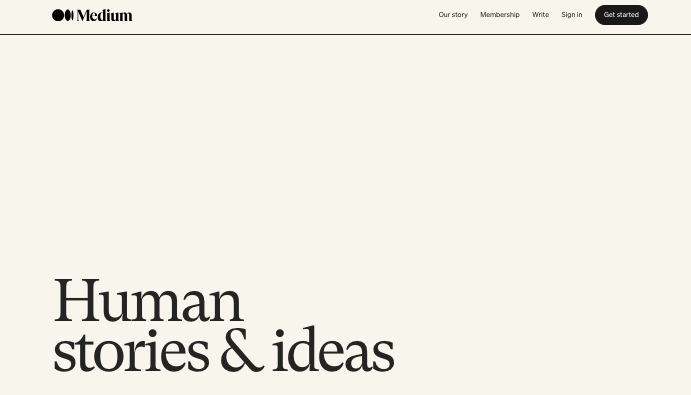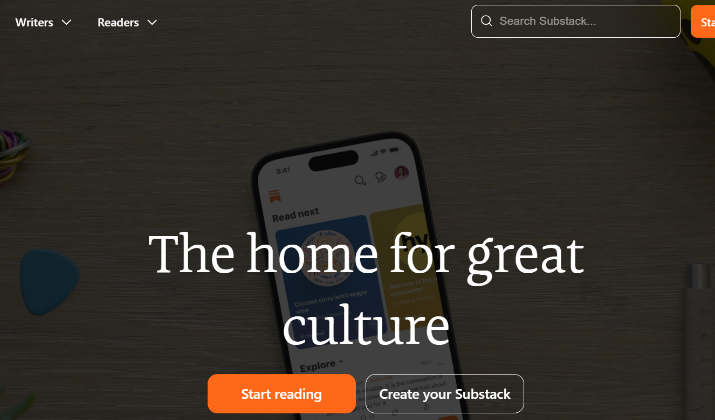Are you a writer on a publishing journey, looking for the right platform to showcase your work and connect with readers?
If that’s the case, you can consider using Substack or Medium, two popular platforms that offer unique opportunities for writers like you.
Whether you’re a beginner exploring the world of writing or an established author seeking new avenues, understanding the differences between the two will help you pick the better tool.
In this comprehensive guide, we’ll delve into the intricacies of both platforms, exploring their monetization options, audience reach, networking capabilities, pricing, unique features, and more.
By the end, you’ll have a clearer picture of which platform aligns best with your goals and aspirations.
Let’s begin.
Also Read: Beehiiv vs Ghost
Medium
When it comes to finding a user-friendly platform that welcomes beginner writers with open arms, Medium is often at the top of the list.
This versatile online publishing platform boasts millions of active readers, offering a great opportunity for writers to connect with a large and diverse audience.
One of the key advantages of Medium is its built-in audience. With over 60 million monthly visitors, Medium provides a platform where writers can showcase their talent to a wide range of readers interested in various topics.
The ready-made audience eliminates the need for writers to build their own following from scratch, providing a head start in gaining visibility and recognition.
In addition to its extensive reach, Medium offers writers detailed analytics on their audience engagement.
By understanding how readers interact with their content, writers can make informed decisions to enhance their writing and tailor it to their audience’s preferences.
Monetization is also made easier on Medium through its Partner Program. Writers can earn income based on the number of paying members who read their articles and convert to paying members through their referral links.
As a result, writers have the opportunity to turn their passion for writing into a sustainable income stream.
With its beginner-friendly interface, built-in audience, and opportunities for monetization, Medium is a powerful platform for writers looking to establish their presence and expand their reach in the digital landscape.
Explore: Beehiiv vs Substack vs ConvertKit
Substack
Substack is a popular blog publishing platform that offers a range of features to help writers monetize their content and engage with their audience.
Unlike Medium, Substack operates on a subscription-based model, allowing writers to earn revenue through paid subscriptions.
One of the major advantages of Substack is its user-friendly interface, making it easy for writers to set up their Substack and start bringing in revenue within just a few hours.
Substack takes a 10% cut when creators begin monetizing their content, and until then, the platform is completely free.
Substack provides creators with detailed statistics, allowing them to track the performance of their content.
Writers can access information such as total views, the number of email recipients, and the open rate.
The subscribers dashboard in Substack displays valuable metrics, including the total number of subscribers, paid subscribers, gross annualized revenue, and subscriber numbers over specific time frames.
Furthermore, Substack offers convenient import functionality, enabling writers to seamlessly transfer their content from platforms like Mailchimp, WordPress, TinyLetter, Tumblr, Stripe, and more.
This makes it easy to transition existing subscribers and preserve continuity.
Beyond its functionality as a blog publishing platform, Substack is known for its community-building features.
Writers on Substack can cross-promote each other’s newsletters, helping to expand their reach and connect with new subscribers.
This collaborative environment fosters a sense of community among writers and readers alike.
Substack also provides additional tools to enhance audience engagement. Writers have the option to incorporate built-in newsletter, podcast, and chat functions into their publications.
This allows them to cater to different preferences, engaging with their audience through multiple mediums and platforms.
With Substack, writers have the advantage of owning their email lists, providing direct access to their audience’s inboxes.
The direct line of communication allows for ongoing engagement and relationship-building with subscribers.
To top it off, Substack has a growing number of top earners who are making tens of thousands of dollars per month on the platform.
The success highlights the potential for writers to generate significant income while enjoying the benefits of Substack’s user-friendly interface and community-oriented features.
Also Read: Best Alternatives To Substack
Monetization Options: Medium vs Substack
Both Medium and Substack offer monetization options for writers, allowing them to earn income from their content.
Take a look at what they offer.
Medium
Medium provides writers with a share of subscription revenue based on reader engagement with their stories.
Writers can earn based on the reading time of paying members and the number of claps they receive.
Additionally, Medium allows writers to place stories behind a paywall for platform members, further increasing their potential for monetizing their content.
Substack
Substack focuses on email newsletters as the primary form of content. With Substack, writers primarily earn based on the number of paid subscribers.
Substack typically takes around 10% of the subscription revenue from writers using its platform.
The creators can benefit from SEO through public archives of their newsletters, attracting more readers and potential subscribers.
Summary
The monetization options provided by Medium and Substack cater to different content types and creator preferences.
Medium supports a variety of content types like articles and essays, while Substack emphasizes email newsletters.
Medium places a significant emphasis on SEO for discoverability, enhancing the writers’ exposure.
On the other hand, Substack provides more design and customization options, allowing creators to create custom landing pages for newsletters and upload banners for branding.
Audience Reach: Medium vs Substack
When it comes to audience reach, both Medium and Substack offer unique advantages that cater to different writer preferences and goals.
Medium
Medium has tens of millions of existing readers, making it easier to gain traction compared to Substack, which requires building an audience from scratch.
With its broad content categories and open platform, Medium offers writers the opportunity to reach a larger, diverse audience.
The platform’s distribution algorithms also help stories spread widely, increasing the chances of reaching a broad readership.
This broad exposure makes Medium an attractive option for writers focused on growth and income.
Substack
Substack’s newsletter-based system builds loyalty among engaged subscribers.
Writers on Substack have a direct connection with their subscribers through their inboxes, creating a more intimate and personal relationship.
This close bond cultivates a core engaged audience, ideal for writers looking to monetize their content.
Substack’s subscription paywall feature allows writers to generate revenue and keep 90% of the earnings after platform fees, creating a potential income stream.
Summary
Both Medium and Substack attract high-quality readers who engage with in-depth content. This engagement increases the likelihood of converting readers into loyal followers.
However, when it comes to search engine optimization (SEO), Medium has the upper hand. Medium consistently ranks higher in Google search results for similar keywords, enhancing discoverability and attracting new readers.
It’s worth noting that there is a growing trend of authors transitioning from Medium to Substack, with notable names advocating for Substack as a better platform.
Some writers perceive Medium as a “sinking ship” due to reduced revenues, stagnated growth, and changes in the distribution model.
Conversely, authors on Substack have reported significant growth in followers and revenue.
Notable success stories include Ossiana Tepfenhart and Walter Rhein, who have seen substantial increases in their following and earnings within months.
Also Read: Beehiiv vs Klaviyo
Strengths: Medium vs Substack
Medium – Networking & Community
When it comes to building connections and fostering a sense of community, Medium excels in providing a platform for writers to network with like-minded individuals.
With its emphasis on engagement and interaction, Medium offers a variety of features that facilitate networking opportunities.
One of the key aspects of Medium’s networking capabilities is its publications function.
Publications on Medium serve as shared spaces where multiple authors can contribute stories centered around a common theme or topic.
This allows writers to connect with other creators, publications, and readers who share similar interests.
By collaborating and contributing to publications, writers can expand their reach and forge valuable connections within their niche.
Moreover, Medium’s engagement features offer writers the opportunity to connect directly with their audience.
Through features like comments and highlights, writers can interact with readers, receive feedback, and engage in meaningful discussions.
This fosters a sense of community and facilitates networking between writers and their audience.
Medium’s larger built-in audience compared to other platforms also plays a crucial role in networking and community building.
With millions of monthly users, Medium provides writers with the potential for greater exposure. Writers have the opportunity to showcase their work to a wider audience through Medium’s staff picks and curation options.
This increased visibility can lead to greater networking opportunities as writers attract the attention of other industry professionals, potential collaborators, or even publishers.
To further enhance networking capabilities, Medium offers recommendations and network effects within its platform.
Through its algorithmic recommendations, Medium suggests relevant content to readers based on their interests, creating opportunities for writers to connect with new readers and expand their network.
Additionally, Medium’s network effects allow writers to tap into the connections and followings of other writers, amplifying their reach and fostering new relationships within the writing community.
Check Out: Beehiiv vs Flodesk
Substack – Personal Engagement
When it comes to personal audience engagement, Substack truly shines. As a writer on Substack, you have the unique ability to cultivate a close relationship with your subscribers.
With direct access to their inboxes, you can deliver personalized content, exclusives, and updates straight to them, fostering a genuine sense of connection.
This direct line of communication allows for more intimate interactions, enabling you to understand your audience’s needs and preferences.
Substack goes beyond traditional text-based newsletters and offers a range of features to enhance audience engagement.
You can host podcasts, videos, and even discussion chats, providing multiple avenues for you to connect and interact with your audience in a way that suits your content and style.
These additional mediums allow for a more immersive and interactive experience, further strengthening the bond with your subscribers.
By focusing on personal audience engagement, Substack empowers writers to build a loyal and devoted following.
This connection goes beyond a simple transactional relationship, creating a community centered around your content.
With Substack, you can foster a sense of exclusivity and make your subscribers feel like valued members of a close-knit group.
Explore: Beehiiv vs Sendfox
Pricing: Medium vs Substack
When it comes to pricing and cost, Medium and Substack offer different options for writers looking to monetize their work.
Medium operates on a subscription-based model, where readers pay $5 a month for unlimited access to the platform, which includes ad-free reading and offline access.
This subscription fee contributes to the earnings of writers, providing a potential revenue stream.
However, it’s important to note that only a small percentage of Medium writers earn between $5,000 to $30,000 a month, typically after 1 to 2 years of consistent writing, while around 94% of writers earn under $100 per month.
This indicates that while Medium has a large audience base of nearly 100 million monthly active users, earning substantial income on the platform can be challenging.
On the other hand, Substack offers a more accessible approach to monetization. Writers can set up their publication for free and keep 90% of the revenues generated by their editorials.
Substack charges a 10% fee for paid subscriptions, making it a straightforward way to earn income from readers.
For example, with 800 subscribers at $7 a month, writers can earn around $4,639 monthly. This level of financial independence is attractive to many writers who prefer to have direct control over their earnings.
It’s worth noting that Substack’s accessibility and revenue-sharing structure make it a popular choice for writers who are just starting out or prefer not to operate on a subscription-based model.
Explore: Best Times To Post On Beehiiv
Which to Pick?
The best way to determine which platform suits your writing ambitions best is by trying both Medium and Substack.
While articles and opinions on the topic can provide insights, the personal experience and perspective of trying each platform are invaluable.
By experimenting with both platforms, writers can discover which features, monetization options, and audience engagement methods align with their goals and writing style.
Also Read: Brevo vs Beehiiv
Conclusion
Medium provides a larger internal audience, advanced analytics, and networking opportunities, making it an ideal choice for writers who seek a wider reach and want to connect with like-minded individuals in their niche.
Substack, though, focuses on personal audience engagement, direct inbox access to subscribers, and the ability to create additional content formats like newsletters.
It is well-suited for writers who prioritize building a loyal community and engaging with their audience on a more intimate level.













